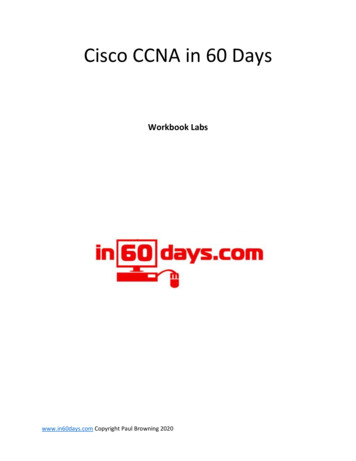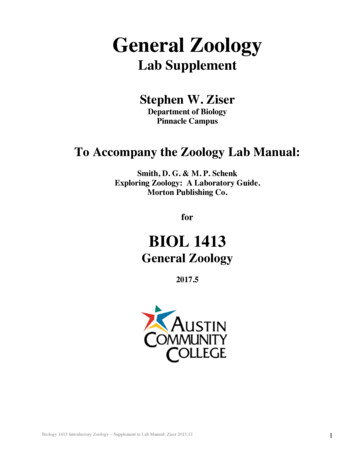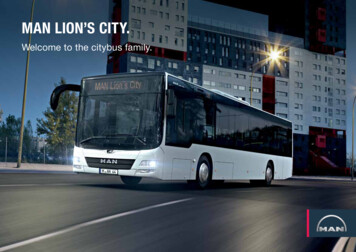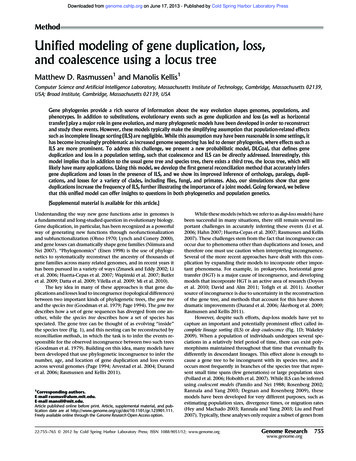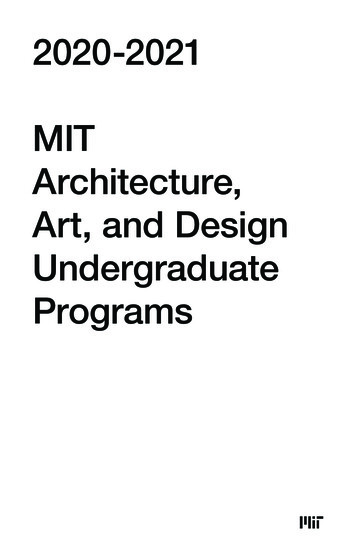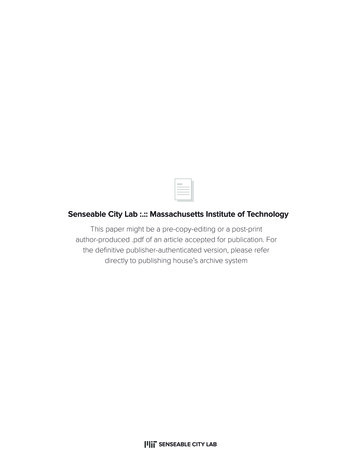
Transcription
Senseable City Lab :.:: Massachusetts Institute of TechnologyThis paper might be a pre-copy-editing or a post-printauthor-produced .pdf of an article accepted for publication. Forthe definitive publisher-authenticated version, please referdirectly to publishing house’s archive systemSENSEABLE CITY LAB
sad0717Ratt3p.indd 545/22/17 5:47 PM
FROMPARKINGLOT TOCarlo Ratti is director of the SenseableCity Lab at the Massachusetts Institute ofTechnology and founder of the Carlo RattiAssociati design studio.Assaf Biderman is an inventor, associatedirector of the Senseable City Lab andfounder of Superpedestrian, a companyfocused on developing robotic vehicles forsingle and double occupancy.By Carlo Ratti and Assaf BidermanCSUSTAINABLE CITIE SA moving web of sensorladen vehicles and smartintersections will transformhow we get around townARS AND CITIES HAVE A COMPLICATEDrelationship. Today, plagued withswelling road congestion and rising air pollution, we tend tothink of the two as increasinglyincompatible. But during the20th century the automobile left one of themost durable marks on city planning. As Swissborn architect Le Corbusier declared in hisseminal 1925 book The City of To-morrow andIts Planning, “The motor-car . has completelyoverturned all our old ideas of town planning.”SPECIAL REPORTPARADISEAlmost 100 years later we are at a similar turning point.First, demand for urban transportation is expected to morethan double by 2050, which means that we will need to morethan double capacity on the roads just to keep congestion atthe (often unacceptable) levels we experience now. Second,thanks to the rapid convergence of information and communication technologies, robotics and artificial intelligence, ourmobility systems—cars, buses and other forms of transportation—are undergoing massive transformations. Once again,July 2017, ScientificAmerican.com 55sad0717Ratt4p.indd 555/23/17 2:27 PM
As each car nears the intersection, it issues anaccess-request signal to the intersection managervia Wi-Fi. The time-stamped signal includes routedetails. Here the red car 1 enters the signalone rst followed by the orange car 2 , thenthe gold 3 and the green 4 cars. 3 hreshold for intersectionaccess request1IntersectionFixedprede nedroutes25SOURCES: SENSEABLE CITY LAB, MASSACHUSETTS INSTITUTE OF TECHNOLOGY;“REVISITING STREET INTERSECTIONS USING SLOT-BASED SYSTEMS,” BY REMI TACHETET AL., IN PLOS ONE, VOL. 11, NO. 3, ARTICLE NO. E0149607; MARCH 16, 20164Car approachingthe signal zoneTail distanceStop distance second batch led by the blue car 5 ,approaches the intersection.For safety vehicles belonging to the same flowmust maintain a speci ed tailgate distance fromone another ehicles in di erent flows are separated by the distance it would ta e them to stop56 Scientific American, July 2017sad0717Ratt4p.indd 56Illustration by Jen Christiansen5/23/17 2:30 PM
Traffic ControlSelf-driving vehicles would enable city planners to replace traffic lights with slot intersections, in which each vehicleapproaching an intersection is assigned a time “slot” when it can pass through. Research suggests that slot intersectionscould allow twice as many vehicles to pass through an intersection in a given amount of time, compared with traffic lights.Slot intersections aremost e cient when vehiclesare grouped together inbatches allowing theautomated-intersectionmanager to reshuffle carorder within one groupof vehicles at a time hisarrangement preventsa string of cars on a moreheavily traveled road fromdominating the system atthe expense of cars headedin the other directionFirst batchRequesttime123Second batch465Accesstime1Time lapse from signalto intersection entryin free-flow conditionsVehicle requestsare reshuffled inthis time interval7243Delay experienced byvehicle 1 in managedintersection conditions567Delay experienced byvehicle 5 in managedintersection conditionsSPECIAL REPORTars turning rightare allowed to umpthe ueue21SUSTAINABLE CITIE Slthough the orange car was the second tore uest access to the intersection and the goldcar was the third the intersection managerdetermined that the gold car was close enoughto the red car to cross the intersection in tandemccordingly the orange car was directed to slowdown and it dropped into the third position33544267July 2017, ScientificAmerican.com 57sad0717Ratt4p.indd 575/23/17 2:30 PM
SUSTAINABLE CITIE SSPECIAL REPORTthey stand poised to radically reshapethe urban landscape.Self-driving (or autonomous) vehiclesare leading the charge. In recent decadescars have shifted from the kinds ofmechanical systems Henry Ford mighthave recognized to veritable computerson wheels. The average car is nowequipped with an array of sensors thatcollect internal and external data to helpit run safely and efficiently. Companiessuch as Waymo (spun out of Google),Cruise (acquired by General Motors),Otto (acquired by Uber), Zoox andnuTonomy, for example, are experimenting with additional sensors that can“see” a street much in the way our eyesdo. Once you feed that information intoan onboard artificial-intelligence system,you get a fully autonomous vehicle,capable of navigating on busy trafficgrids without any human input.Autonomous cars will free up muchof the time we spend every day driving,and they will make our roads safer. Theyare going to be game changers for ourcities—but in ways that are far fromdecided. On one hand, we can imaginethat more people will begin to sharethese vehicles so that the machines cangive lifts to one passenger after the other, all day long. In that case, our citiesmight run using a small fraction of thevehicles currently in service. On the other hand, we might have more dystopianscenarios. Robin Chase, co-founder andformer CEO of the car-sharing serviceZipcar, has written of “zombie cars—those with no one in them — clogging ourcities and our roads.” Her vision foreseesunemployment for professional drivers,lost revenue from our transportationinfrastructure, and “a nightmare of pollution, congestion, and social unrest.”Technological nirvana or urban dystopia? To tackle this question, we need todelve into the ways autonomous vehiclescould alter our cityscapes and the wayswe move through them.THE SHARING ECONOMYON AVERAGE, cars sit idle 96 percent ofthe time. That makes them ideal candidates for the sharing economy. Thepotential to reduce congestion is enormous. A handful of car-sharing systems—such as Zipcar and car2go—arealready having a major impact on thetotal number of vehicles in our cities.Scholars have estimated that everyshared vehicle removes nine to 13 privately owned cars from the streets.The benefits will grow exponentiallyas autonomous vehicles, currently available in experimental forms, gain a notable portion of the market, blurring thedistinction between private and publicmodes of transportation. “Your” car couldgive you a lift to work in the morning andthen, rather than sitting in a parking lot,give a lift to someone else in your family—or to anyone else in your neighborhood or social media community.As a result, a single vehicle could gofrom one to 24 hours of use a day. Arecent paper by our colleagues at the Massachusetts Institute of Technology reportsthat, under such conditions, the mobilitydemand of a city like Singapore—host toone of the world’s first publicly accessiblefleets of self-driving cars—could be metwith only 30 percent of its existing vehicles. In addition to vehicle sharing, auton-Francisco, Vienna and Singapore couldbenefit in similar measure.Combine car sharing and ride sharing,and a city might get by with just 20 percent the number of cars now in use, withits residents traveling on-demand. Ofcourse, such reductions are theoretical. Inreal life, they would depend on how willing people are to share rides and adoptself-driving technology. But any drop inthe number of vehicles could lower thecosts and energy associated with buildingand maintaining our mobility infrastructure. Fewer cars might also mean shortertravel times, less congestion and a smallerenvironmental impact.NO PARKING, NO TRAFFIC LIGHTSAUTONOMOUS CARS will not require additional urban infrastructure—speciallydesigned roads, for example—but they willlead to other significant changes. Considerparking. In the U.S., parking infrastructurecovers around 8,000 square miles, an areaVast areas of urban land could beredeveloped to support social functions.omy could open up a new wave of ridesharing. Already applications such as Via ,uberPOOL and Lyft Line allow differentpeople to share the same ride, cuttingoperating costs and individual fares.Autonomy could boost ride sharing evenmore because all trips could be managedonline. In cities, the potential for ridesharing is significant, based on analysesby our Senseable City Lab at M.I.T.New York City, for example, is eminently shareable. Our lab’s HubCab project gathered data from 170 million taxitrips involving 13,500 Medallion taxis inthe city—specifically, the GPS coordinatesfor all pickup and drop-off points andcorresponding times between the two.We then developed a mathematical model to determine the potential effect of ridesharing applied to those journeys. Theproject introduced the concept of “shareability networks,” making it possible tooptimize the trip-sharing opportunities.Our quantitative results revealed howtaxi sharing could reduce the aggregatenumber of cars by 40 percent with onlyminimal delays for passengers. Furtherwork showed that places such as Sannearly as large as New Jersey. If more vehicles were shared, we would need dramatically fewer parking spaces. What wouldthe consequences be?Over time, vast areas of valuableurban land, currently occupied by parking lots, could be redeveloped to supporta whole new spectrum of social functions. Park(ing) Day, an annual event firstheld in San Francisco in 2005, offers somepreliminary ideas. Every year the eventchallenges artists, designers and citizensto transform metered parking spots intotemporary public places. In the past, participants have rolled out sod and placedtrees and benches along the curbside.On a much larger scale and on a permanent basis, vacant parking lots couldbe converted to offer shared public amenities such as playgrounds, cafés, fitnesstrails and bike lanes.Other common sights along our citystreets might vanish. Take traffic lights,a 150-year-old technology originally conceived to help horse carriages avoid collisions. Sensor-laden self-driving vehicles,which can communicate with one another to maintain safe distances, will need58 Scientific American, July 2017sad0717Ratt3p.indd 585/22/17 5:47 PM
less assistance at road crossings. As aresult, slot-based intersections, modeledafter air traffic control systems, couldreplace traffic lights. On approachingan intersection, a vehicle would automatically contact a traffic-management system to request access. It would then beassigned an individualized time, or “slot,”to pass through the intersection.Slot-based intersections could significantly reduce queues and delays, as ourLight Traffic project has demonstrated.Analyses show that systems assigningslots in real time could allow twice asmany vehicles to cross an intersection inthe same amount of time as traffic lightsusually do. This arrangement could havea major impact on the road network ofany given city. Travel and waiting timeswould drop; fuel consumption would godown; and less stop-and-go traffic wouldmean less air pollution. As an addedbonus, slot-based intersections are flexible enough to accommodate pedestriansand bicycles sharing the road.It is worth noting that such an enticing vision depends on more than justautonomous cars and smart traffic-management systems. It also requires muchbetter market coordination. Today’s carsharing companies have independentplatforms that do not talk to one another.Customers cannot compare options easily,and drivers cannot benefit from aggregated demand. The situation is similar tohow the air travel industry looked beforethe Internet. Passengers can now compare many flight alternatives throughseveral global distribution systems thatfollow standards established by the OpenTravel Alliance and thus benefit fromincreased transparency and competition.In cities, two approaches could createa similar mobility architecture. The firstwould be a bottom-up effort in whichsmall players start adopting standards.This is beginning to happen with a collaboration among Lyft, Didi Chuxing inChina, Ola in India and GrabTaxi inSoutheast Asia. The second effort wouldbe top down, led by a government or aglobal organization, such as the WorldWide Web Consortium. Because transportation services are already heavily regulated in most countries, this would not betoo far-fetched. Either approach couldcreate an incredibly powerful and transparent platform for transportation andlogistical services.POTENTIAL PITFALLSVEHICLE AUTONOMY and ride sharing couldcreate overwhelmingly positive changesin urban transportation. But if the transition to the driverless city is not managed carefully, it could also lead to negative consequences.The first concern is safety. We allknow what it is like for a virus to crasha computer. What if a virus crashes acar? Malicious hacking is difficult tocombat with traditional government andindustry tools, and it is particularly dangerous in the case of systems, such asself-driving cars, that combine the digital and the physical.Additional problems might arisefrom what one could call the “unfaircompetitive advantage” of vehicle autonomy. The cost of traveling a mile mightdrop so substantially that people wouldabandon public transportation in favorof autonomous cars. That, in turn, couldlead to an increase in the number ofvehicles in a city—and with that increase, surreal gridlock. Additionally,keeping cars moving at all hours ratherthan parked 96 percent of the time couldincrease pollution.Autonomous cars might generateanother unintended consequence:aggravating urban sprawl. This wouldnot be the first time that a technologicalinnovation in mobility resulted in suchan effect. In his 1941 book The FourRoutes, Le Corbusier described how thisunfolded in the first decades of the 20thcentury: “The railway converted the cities into true magnets; they filled andswelled without control, and the countryside was progressively abandoned. Itwas a disaster. Luckily the automobile,through the organization of the roads,will reestablish this broken harmonyand start the repopulation of the coun-tryside.” In the future, what if people,newly able to commute while sleepingor working, decide to relocate out of thecity, consuming land and expandingunsustainable, sprawling communities?A couple of other threats are worthmentioning. Fines, parking fees andcar-associated taxes such as driverregistrations represent a substantialrevenue source for all kinds of localand national jurisdictions. Widespreadautonomous vehicles could eliminatethis crucial flow of money. We can easilyimagine what would happen to alreadybattered American infrastructure if thisscenario were to come true. Perhaps cities could compensate by redevelopingunneeded parking lots and buildingnew, revenue-producing infrastructure.But we must also remember that millions of drivers working today in logistics or urban transport jobs could be leftunemployed worldwide.As Robin Chase wrote, “Simply eliminating the drivers from cars, and keeping everything else about our system thesame, will be a disaster.” As a result, it isimperative that we view these newtechnologies with a critical eye—andguide them toward the societal goalswe desire. Good policy could help prevent the negative outcomes we havedescribed. As was the case in the 20thcentury, much will depend on a healthycycle of trial and error.Still, if we can manage the transitionin a thoughtful way, self-driving carscould help us achieve a safer and morepleasant urban experience. In doing so,they could ultimately enhance the verymission of our cities, which dates to theemergence of the first human settlements 10,000 years ago—bringing ustogether, regardless of the kind of vehicles we are moving in.M O R E TO E X P L O R ETrash-to-Treasure: Turning Nonrecycled Waste into Low-Carbon Fuel. Alex C. Breckel, John R. Fyffe andMichael E. Webber in EARTH, Vol. 57, No. 8, pages 42–47; August 2012.The Upcycle: Beyond Sustainability—Designing for Abundance. William McDonough and Michael Braungart.North Point Press, 2013.For details about Park 20 20: www.park2020.com/enMassachusetts Institute of Technology’s Senseable City Lab: http://senseable.mit.eduFROM OUR ARCHIVESWaste Energy. George Hill; May 12, 1894.The Efficient City. Mark Fischetti; September 2011.s c i e n t i f i c a m e r i c a n . c o m /m a g a z i n e /s aJuly 2017, ScientificAmerican.com 59sad0717Ratt3p.indd 595/22/17 5:47 PM
less assistance at road crossings. As a result, slot-based intersections, modeled after air tra"c control systems, could replace tra"c lights. On approaching an intersection, a vehicle would automat-ically contact a tra"c-management sys-tem to request access. It would then be assigned an individualized time, or "slot,"






